中国四大菜系英文介绍
- 格式:ppt
- 大小:8.74 MB
- 文档页数:49
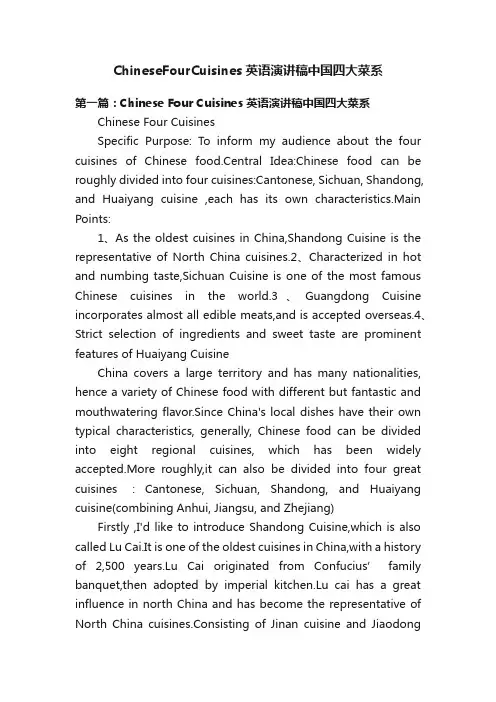
ChineseFourCuisines英语演讲稿中国四大菜系第一篇:Chinese Four Cuisines 英语演讲稿中国四大菜系Chinese Four CuisinesSpecific Purpose: To inform my audience about the four cuisines of Chinese food.Central Idea:Chinese food can be roughly divided into four cuisines:Cantonese, Sichuan, Shandong, and Huaiyang cuisine ,each has its own characteristics.Main Points:1、As the oldest cuisines in China,Shandong Cuisine is the representative of North China cuisines.2、Characterized in hot and numbing taste,Sichuan Cuisine is one of the most famous Chinese cuisines in the world.3、Guangdong Cuisine incorporates almost all edible meats,and is accepted overseas.4、Strict selection of ingredients and sweet taste are prominent features of Huaiyang CuisineChina covers a large territory and has many nationalities, hence a variety of Chinese food with different but fantastic and mouthwatering flavor.Since China's local dishes have their own typical characteristics, generally, Chinese food can be divided into eight regional cuisines, which has been widely accepted.More roughly,it can also be divided into four great cuisines :Cantonese, Sichuan, Shandong, and Huaiyang cuisine(combining Anhui, Jiangsu, and Zhejiang)Firstly ,I'd like to introduce Shandong Cuisine,which is also called Lu Cai.It is one of the oldest cuisines in China,with a history of 2,500 years.Lu Cai originated from Confucius’ family banquet,then adopted by imperial kitchen.Lu cai has a great influence in north China and has become the representative of North China cuisines.Consisting of Jinan cuisine and Jiaodongcuisine, Shandong cuisine, clear, pure and not greasy, is characterized by its emphasis on aroma, freshness, crispness.Shallot and garlic are usually used as seasonings so Shangdong dishes usually tastes pungent.It specializes in seafood like prawns, sea cucumber.Soups are given much emphasis in Shangdong dishes.Thin soup features clear and fresh while creamy soup looks thick and tastes strong.The next one is Sichuan Cuisine,which is one of the fastest growing cuisines in the world.Learning from other cuisines and cooking in its own style makes Sichuan Cuisine one of the most famous Chinese cuisines in the world.It is characterized in hot and numbing taste by using a lot of peppercorns and spices.Pepper and prickly ash also never fail to accompany, producing typical exciting tastes.Wild vegetables and animals are usually chosen as ingredients.It is said that one who doesn't experience Sichuan food never reaches China.Now,what is showed is Guangdong Cuisine.Nowadays, most Chinese restaurants overseas serve mainly Cantonese food.Cantonese cuisine incorporates almost all edible meats, including organ meats, chicken feet, duck and duck tongues, snakes, and snails.Freshest and quality ingredients are crucial.Spices should be used in modest amounts to avoid overwhelming the flavors of the primary ingredients.Here is Huaiyang Cuisine.Huaiyang Cuisine has strict selection of ingredients according to seasons.It used to be expensive and luxury.Sweet is the most prominent feature of Huaiyang Cuisine, nearly not spicy at all.And cutting of the material is the key factor for a good dish.Pork, fresh water fish, and other aquatic creatures serve as the meat base to most dishes.These are the Four Great cuisines of Chinese food.I hope the informations are useful for you.Thank you for your listening!第二篇:《四大菜系》教学设计[范文模版]《四大菜系》教学设计阳信县金阳街道中心小学曹云英《四大菜系》是齐鲁书社版《传统文化》五年级下册饮食文化单元中的第三课,主要介绍中国的菜系文化内容,通过学习让学生了解掌握中国的四大菜系,欣赏中国饮食文化的特点,同时通过本课的学习感受中国饮食文化的博大精深,进一步激发学生探索饮食文化的兴趣。
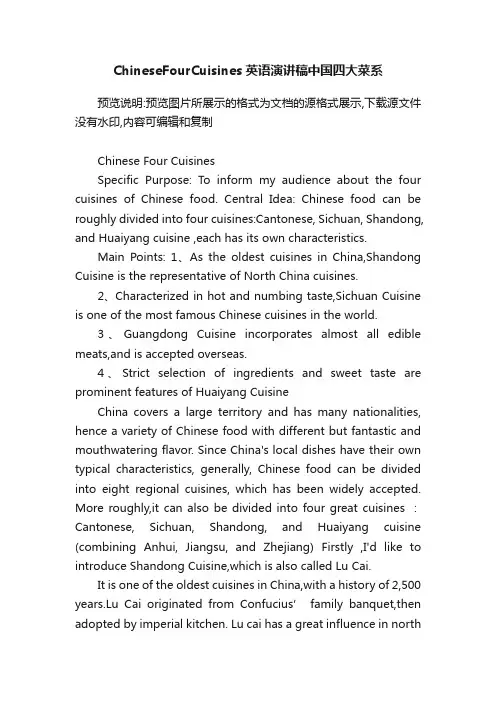
ChineseFourCuisines英语演讲稿中国四大菜系预览说明:预览图片所展示的格式为文档的源格式展示,下载源文件没有水印,内容可编辑和复制Chinese Four CuisinesSpecific Purpose: To inform my audience about the four cuisines of Chinese food. Central Idea: Chinese food can be roughly divided into four cuisines:Cantonese, Sichuan, Shandong, and Huaiyang cuisine ,each has its own characteristics.Main Points: 1、As the oldest cuisines in China,Shandong Cuisine is the representative of North China cuisines.2、Characterized in hot and numbing taste,Sichuan Cuisine is one of the most famous Chinese cuisines in the world.3、Guangdong Cuisine incorporates almost all edible meats,and is accepted overseas.4、Strict selection of ingredients and sweet taste are prominent features of Huaiyang CuisineChina covers a large territory and has many nationalities, hence a variety of Chinese food with different but fantastic and mouthwatering flavor. Since China's local dishes have their own typical characteristics, generally, Chinese food can be divided into eight regional cuisines, which has been widely accepted. More roughly,it can also be divided into four great cuisines :Cantonese, Sichuan, Shandong, and Huaiyang cuisine (combining Anhui, Jiangsu, and Zhejiang) Firstly ,I'd like to introduce Shandong Cuisine,which is also called Lu Cai.It is one of the oldest cuisines in China,with a history of 2,500 years.Lu Cai originated from Confucius’ family banquet,then adopted by imperial kitchen. Lu cai has a great influence in northChina and has become the representative of North China cuisines.Consisting of Jinan cuisine and Jiaodong cuisine, Shandong cuisine, clear, pure and not greasy, is characterized by its emphasis on aroma, freshness, crispness . Shallot and garlic are usually used as seasonings so Shangdong dishes usually tastes pungent. It specializes in seafood like prawns, sea cucumber. Soups are given much emphasis in Shangdong dishes. Thin soup features clear and fresh while creamy soup looks thick and tastes strong.The next one is Sichuan Cuisine,which is one of the fastest growing cuisines in the world.Learning from other cuisines and cooking in its own style makes Sichuan Cuisine one of the most famous Chinese cuisines in the world.It is characterized in hot and numbing taste by using a lot of peppercorns and spices.Pepper and prickly ash also never fail to accompany, producing typical exciting tastes. Wild vegetables and animals are usually chosen as ingredients.It is said that one who doesn't experience Sichuan food never reaches China.Now,what is showed is Guangdong Cuisine.Nowadays, most Chinese restaurants overseas serve mainly Cantonese food.Cantonese cuisine incorporates almost all edible meats, including organ meats, chicken feet, duck and duck tongues, snakes, and snails.Freshest and quality ingredients are crucial. Spices should be used in modest amounts to avoid overwhelming the flavors of the primary ingredients.Here is Huaiyang Cuisine. Huaiyang Cuisine has strict selection of ingredients according to seasons. It used to be expensive and luxury. Sweet is the most prominent feature ofHuaiyang Cuisine, nearly not spicy at all.And cutting of the material is the key factor for a good dish.Pork, fresh water fish, and other aquatic creatures serve as the meat base to most dishes.These are the Four Great cuisines of Chinese food.I hope the informations are useful for you.Thank you for your listening!。
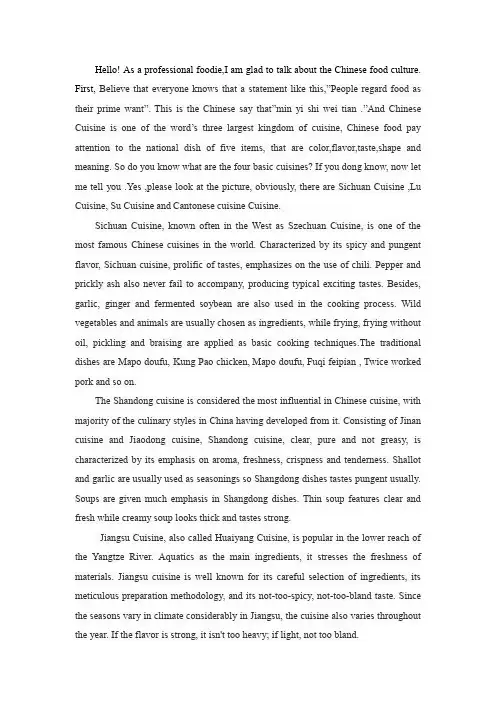
Hello! As a professional foodie,I am glad to talk about the Chinese food culture. First, Believe that everyone knows that a statement like this,”People regard food as their prime want”.This is the Chinese say that”min yi shi wei tian .”And Chinese Cuisine is one of the word’s three largest kingdom of cuisine,Chinese food pay attention to the national dish of five items, that are color,flavor,taste,shape and meaning. So do you know what are the four basic cuisines? If you dong know, now let me tell you .Yes ,please look at the picture, obviously, there are Sichuan Cuisine ,Lu Cuisine, Su Cuisine and Cantonese cuisine Cuisine.Sichuan Cuisine, known often in the West as Szechuan Cuisine, is one of the most famous Chinese cuisines in the world. Characterized by its spicy and pungent flavor, Sichuan cuisine, prolific of tastes, emphasizes on the use of chili. Pepper and prickly ash also never fail to accompany, producing typical exciting tastes. Besides, garlic, ginger and fermented soybean are also used in the cooking process. Wild vegetables and animals are usually chosen as ingredients, while frying, frying without oil, pickling and braising are applied as basic cooking techniques.The traditional dishes are Mapo doufu, Kung Pao chicken,Mapo doufu,Fuqi feipian ,Twice worked pork and so on.The Shandong cuisine is considered the most influential in Chinese cuisine, with majority of the culinary styles in China having developed from it. Consisting of Jinan cuisine and Jiaodong cuisine, Shandong cuisine, clear, pure and not greasy, is characterized by its emphasis on aroma, freshness, crispness and tenderness. Shallot and garlic are usually used as seasonings so Shangdong dishes tastes pungent usually. Soups are given much emphasis in Shangdong dishes. Thin soup features clear and fresh while creamy soup looks thick and tastes strong.Jiangsu Cuisine, also called Huaiyang Cuisine, is popular in the lower reach of the Yangtze River. Aquatics as the main ingredients, it stresses the freshness of materials. Jiangsu cuisine is well known for its careful selection of ingredients, its meticulous preparation methodology, and its not-too-spicy, not-too-bland taste. Since the seasons vary in climate considerably in Jiangsu, the cuisine also varies throughout the year. If the flavor is strong, it isn't too heavy; if light, not too bland.Cantonese food originates from Guangdong, the southernmost province in China. The majority of overseas Chinese people are from Guangdong (Canton)so Cantonese is perhaps the most widely available Chinese regional cuisine outside of China.Cantonese are known to have an adventurous palate, able to eat many different kinds of meats and vegetables. In fact, people in Northern China often say that Cantonese people will eat anything that flies except airplanes, anything that moves on the ground except trains, and anything that moves in the water except boats.。
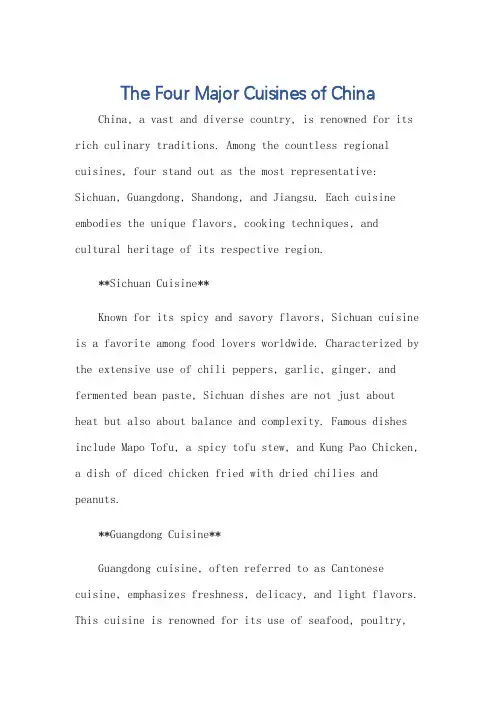
The Four Major Cuisines of ChinaChina, a vast and diverse country, is renowned for its rich culinary traditions. Among the countless regional cuisines, four stand out as the most representative: Sichuan, Guangdong, Shandong, and Jiangsu. Each cuisine embodies the unique flavors, cooking techniques, and cultural heritage of its respective region.**Sichuan Cuisine**Known for its spicy and savory flavors, Sichuan cuisine is a favorite among food lovers worldwide. Characterized by the extensive use of chili peppers, garlic, ginger, and fermented bean paste, Sichuan dishes are not just about heat but also about balance and complexity. Famous dishes include Mapo Tofu, a spicy tofu stew, and Kung Pao Chicken, a dish of diced chicken fried with dried chilies and peanuts.**Guangdong Cuisine**Guangdong cuisine, often referred to as Cantonese cuisine, emphasizes freshness, delicacy, and light flavors. This cuisine is renowned for its use of seafood, poultry,and vegetables, often cooked with minimal seasoning toallow the natural flavors of the ingredients to shine. Dim Sum, the iconic small, steamed buns filled with various fillings, is a prime example of Guangdong cuisine's finesse and creativity.**Shandong Cuisine**Shandong, or Lu cuisine, is known for its emphasis on soup-making and seafood. This cuisine, influenced by Confucianism, values harmony and balance in its dishes. Shandong chefs are masters of cooking techniques such as braising and stewing, resulting in dishes that are rich in flavor and texture. A typical Shandong dish is the Braised Chicken with Brown Sauce, a dish that showcases thecuisine's skill in balancing sweet, savory, and umami flavors.**Jiangsu Cuisine**Jiangsu cuisine, often referred to as Su cuisine, is renowned for its sweet and delicate flavors. This cuisine, influenced by the rich waterways of the Yangtze River, features an abundance of seafood and freshwater fish dishes. Chefs in Jiangsu are masters of precision cooking,resulting in dishes that are both visually appealing and flavorful. A classic example is the Red-Braised Pork Belly, a dish that combines sweet, savory, and umami flavors in a lush, succulent texture.In conclusion, the four major cuisines of China each offer a unique and delicious taste of the country's rich cultural heritage. From the spicy heat of Sichuan to the freshness of Guangdong, the balance of Shandong, and the sweetness of Jiangsu, these cuisines offer a diverse and delicious palette of flavors that are truly representative of China's vast and diverse culinary traditions.**中国四大菜系**中国,这个广阔而多元的国家,因其丰富的烹饪传统而闻名于世。
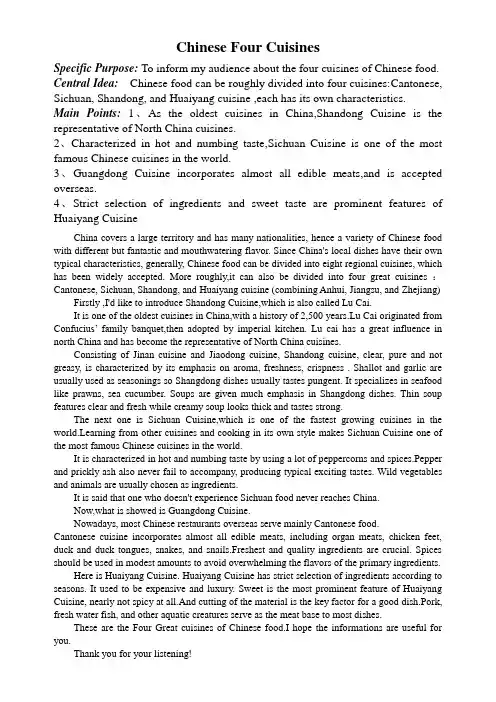
Chinese Four CuisinesSpecific Purpose: To inform my audience about the four cuisines of Chinese food. Central Idea: Chinese food can be roughly divided into four cuisines:Cantonese, Sichuan, Shandong, and Huaiyang cuisine ,each has its own characteristics.Main Points: 1、As the oldest cuisines in China,Shandong Cuisine is the representative of North China cuisines.2、Characterized in hot and numbing taste,Sichuan Cuisine is one of the most famous Chinese cuisines in the world.3、Guangdong Cuisine incorporates almost all edible meats,and is accepted overseas.4、Strict selection of ingredients and sweet taste are prominent features of Huaiyang CuisineChina covers a large territory and has many nationalities, hence a variety of Chinese food with different but fantastic and mouthwatering flavor. Since China's local dishes have their own typical characteristics, generally, Chinese food can be divided into eight regional cuisines, which has been widely accepted. More roughly,it can also be divided into four great cuisines :Cantonese, Sichuan, Shandong, and Huaiyang cuisine (combining Anhui, Jiangsu, and Zhejiang) Firstly ,I'd like to introduce Shandong Cuisine,which is also called Lu Cai.It is one of the oldest cuisines in China,with a history of 2,500 years.Lu Cai originated from Confucius’ family banquet,then adopted by imperial kitchen. Lu cai has a great influence in north China and has become the representative of North China cuisines.Consisting of Jinan cuisine and Jiaodong cuisine, Shandong cuisine, clear, pure and not greasy, is characterized by its emphasis on aroma, freshness, crispness . Shallot and garlic are usually used as seasonings so Shangdong dishes usually tastes pungent. It specializes in seafood like prawns, sea cucumber. Soups are given much emphasis in Shangdong dishes. Thin soup features clear and fresh while creamy soup looks thick and tastes strong.The next one is Sichuan Cuisine,which is one of the fastest growing cuisines in the world.Learning from other cuisines and cooking in its own style makes Sichuan Cuisine one of the most famous Chinese cuisines in the world.It is characterized in hot and numbing taste by using a lot of peppercorns and spices.Pepper and prickly ash also never fail to accompany, producing typical exciting tastes. Wild vegetables and animals are usually chosen as ingredients.It is said that one who doesn't experience Sichuan food never reaches China.Now,what is showed is Guangdong Cuisine.Nowadays, most Chinese restaurants overseas serve mainly Cantonese food.Cantonese cuisine incorporates almost all edible meats, including organ meats, chicken feet, duck and duck tongues, snakes, and snails.Freshest and quality ingredients are crucial. Spices should be used in modest amounts to avoid overwhelming the flavors of the primary ingredients.Here is Huaiyang Cuisine. Huaiyang Cuisine has strict selection of ingredients according to seasons. It used to be expensive and luxury. Sweet is the most prominent feature of Huaiyang Cuisine, nearly not spicy at all.And cutting of the material is the key factor for a good dish.Pork, fresh water fish, and other aquatic creatures serve as the meat base to most dishes.These are the Four Great cuisines of Chinese food.I hope the informations are useful for you.Thank you for your listening!。
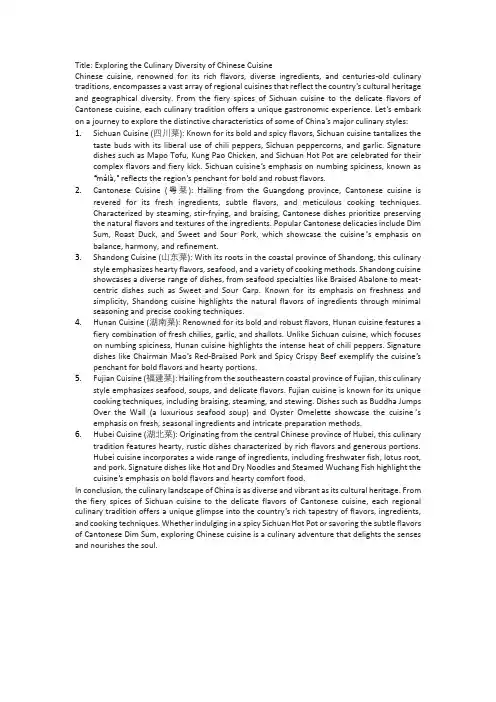
Title: Exploring the Culinary Diversity of Chinese CuisineChinese cuisine, renowned for its rich flavors, diverse ingredients, and centuries-old culinary traditions, encompasses a vast array of regional cuisines that reflect the country’s cultural heritage and geographical diversity. From the fiery spices of Sichuan cuisine to the delicate flavors of Cantonese cuisine, each culinary tradition offers a unique gastronomic experience. Let’s embark on a journey to explore the distinctive characteristics of some of China’s major culinary styles: 1.Sichuan Cuisine (四川菜): Known for its bold and spicy flavors, Sichuan cuisine tantalizes thetaste buds with its liberal use of chili peppers, Sichuan peppercorns, and garlic. Signature dishes such as Mapo Tofu, Kung Pao Chicken, and Sichuan Hot Pot are celebrated for their complex flavors and fiery kick. Sichuan cuisine’s emphasis on numbing spiciness, known as “málà,” reflects the region’s penchant for bold and robust flavors.2.Cantonese Cuisine (粤菜): Hailing from the Guangdong province, Cantonese cuisine isrevered for its fresh ingredients, subtle flavors, and meticulous cooking techniques.Characterized by steaming, stir-frying, and braising, Cantonese dishes prioritize preserving the natural flavors and textures of the ingredients. Popular Cantonese delicacies include Dim Sum, Roast Duck, and Sweet and Sour Pork, which showcase the cuisine’s emphasis on balance, harmony, and refinement.3.Shandong Cuisine (山东菜): With its roots in the coastal province of Shandong, this culinarystyle emphasizes hearty flavors, seafood, and a variety of cooking methods. Shandong cuisine showcases a diverse range of dishes, from seafood specialties like Braised Abalone to meat-centric dishes such as Sweet and Sour Carp. Known for its emphasis on freshness and simplicity, Shandong cuisine highlights the natural flavors of ingredients through minimal seasoning and precise cooking techniques.4.Hunan Cuisine (湖南菜): Renowned for its bold and robust flavors, Hunan cuisine features afiery combination of fresh chilies, garlic, and shallots. Unlike Sichuan cuisine, which focuses on numbing spiciness, Hunan cuisine highlights the intense heat of chili peppers. Signature dishes like Chairman Mao’s Red-Braised Pork and Spicy Crispy Beef exemplify the cuisine’s penchant for bold flavors and hearty portions.5.Fujian Cuisine (福建菜): Hailing from the southeastern coastal province of Fujian, this culinarystyle emphasizes seafood, soups, and delicate flavors. Fujian cuisine is known for its unique cooking techniques, including braising, steaming, and stewing. Dishes such as Buddha Jumps Over the Wall (a luxurious seafood soup) and Oyster Omelette showcase the cuisine’s emphasis on fresh, seasonal ingredients and intricate preparation methods.6.Hubei Cuisine (湖北菜): Originating from the central Chinese province of Hubei, this culinarytradition features hearty, rustic dishes characterized by rich flavors and generous portions.Hubei cuisine incorporates a wide range of ingredients, including freshwater fish, lotus root, and pork. Signature dishes like Hot and Dry Noodles and Steamed Wuchang Fish highlight the cuisine’s emphasis on bold flavors and hearty comfort food.In conclusion, the culinary landscape of China is as diverse and vibrant as its cultural heritage. From the fiery spices of Sichuan cuisine to the delicate flavors of Cantonese cuisine, each regional culinary tradition offers a unique glimpse into the country’s rich tapestry of flavors, ingredients, and cooking techniques. Whether indulging in a spicy Sichuan Hot Pot or savoring the subtle flavors of Cantonese Dim Sum, exploring Chinese cuisine is a culinary adventure that delights the senses and nourishes the soul.。
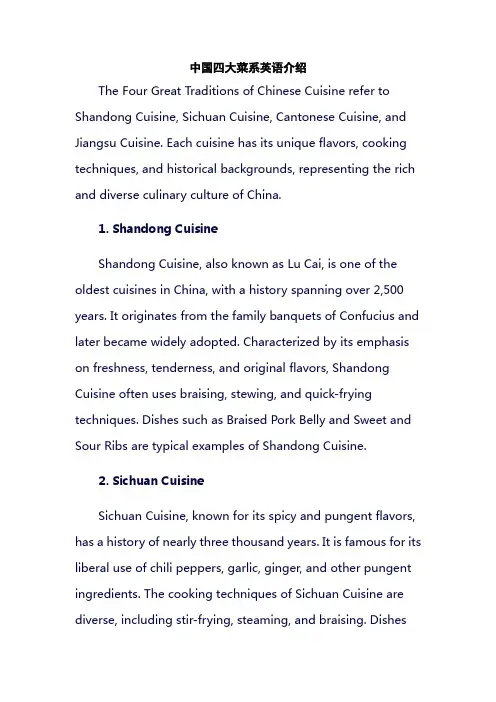
中国四大菜系英语介绍The Four Great Traditions of Chinese Cuisine refer to Shandong Cuisine, Sichuan Cuisine, Cantonese Cuisine, and Jiangsu Cuisine. Each cuisine has its unique flavors, cooking techniques, and historical backgrounds, representing the rich and diverse culinary culture of China.1. Shandong CuisineShandong Cuisine, also known as Lu Cai, is one of the oldest cuisines in China, with a history spanning over 2,500 years. It originates from the family banquets of Confucius and later became widely adopted. Characterized by its emphasis on freshness, tenderness, and original flavors, Shandong Cuisine often uses braising, stewing, and quick-frying techniques. Dishes such as Braised Pork Belly and Sweet and Sour Ribs are typical examples of Shandong Cuisine.2. Sichuan CuisineSichuan Cuisine, known for its spicy and pungent flavors, has a history of nearly three thousand years. It is famous for its liberal use of chili peppers, garlic, ginger, and other pungent ingredients. The cooking techniques of Sichuan Cuisine are diverse, including stir-frying, steaming, and braising. Disheslike Mapo Tofu, Spicy Chicken, and Fish Fragrant Prawns are all representative of Sichuan Cuisine's unique flavors.3. Cantonese CuisineCantonese Cuisine, originating in Guangdong Province, is renowned for its light and delicate flavors. It emphasizes the freshness and original taste of ingredients, often using steaming, stir-frying, and roasting techniques. Cantonese Cuisine is also known for its innovative use of seafood and its meticulous preparation methods. Dishes like Roast Goose, Dim Sum, and Steamed Fish with Ginger and Scallions are typical examples of Cantonese Cuisine.4. Jiangsu CuisineJiangsu Cuisine, also known as Su Cai, is known for its emphasis on freshness, tenderness, and original flavors. It often uses light seasonings and cooking techniques such as steaming, stewing, and braising to preserve the natural flavors of the ingredients. Dishes like Lion's Head Meatballs, Crab Meat Soup, and Sweet and Sour Pork Ribs are representative of Jiangsu Cuisine's delicate and refreshing flavors.In conclusion, the Four Great Traditions of Chinese Cuisine each have their unique characteristics and flavors, reflecting the rich and diverse culinary culture of China. Whether you prefer the freshness and tenderness of Shandong Cuisine, the spicy and pungent flavors of Sichuan Cuisine, the light and delicate flavors of Cantonese Cuisine, or the refreshing and delicate flavors of Jiangsu Cuisine, there is sure to be a dish that will satisfy your taste buds.。
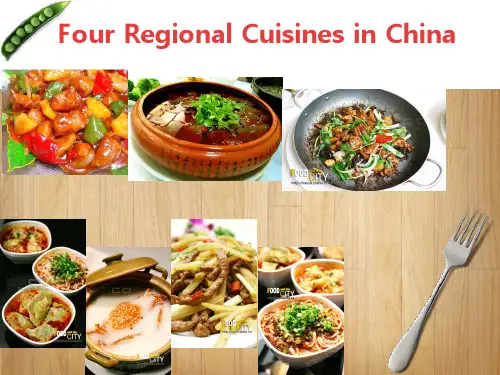
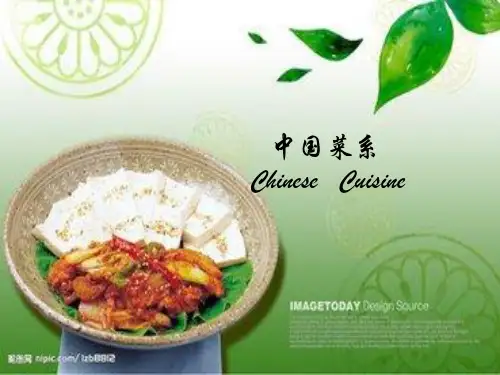
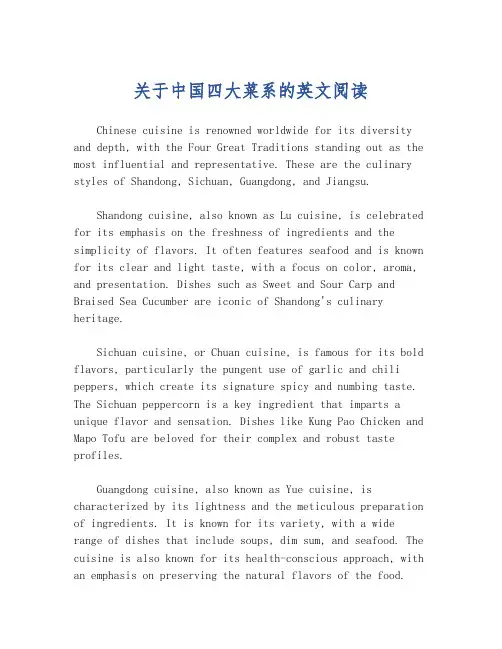
关于中国四大菜系的英文阅读Chinese cuisine is renowned worldwide for its diversity and depth, with the Four Great Traditions standing out as the most influential and representative. These are the culinary styles of Shandong, Sichuan, Guangdong, and Jiangsu.Shandong cuisine, also known as Lu cuisine, is celebrated for its emphasis on the freshness of ingredients and the simplicity of flavors. It often features seafood and is known for its clear and light taste, with a focus on color, aroma, and presentation. Dishes such as Sweet and Sour Carp and Braised Sea Cucumber are iconic of Shandong's culinary heritage.Sichuan cuisine, or Chuan cuisine, is famous for its bold flavors, particularly the pungent use of garlic and chili peppers, which create its signature spicy and numbing taste. The Sichuan peppercorn is a key ingredient that imparts a unique flavor and sensation. Dishes like Kung Pao Chicken and Mapo Tofu are beloved for their complex and robust taste profiles.Guangdong cuisine, also known as Yue cuisine, is characterized by its lightness and the meticulous preparation of ingredients. It is known for its variety, with a wide range of dishes that include soups, dim sum, and seafood. The cuisine is also known for its health-conscious approach, with an emphasis on preserving the natural flavors of the food.Cantonese Roast Duck and Steamed Fish Head with Diced Hot Red Chili are among the many delicacies that showcase Guangdong's culinary prowess.Jiangsu cuisine, or Su cuisine, is known for its delicate flavors and the intricate preparation techniques. It is often described as sweet and fresh, with an emphasis on the harmony of flavors. The use of sugar is subtle, enhancing rather than overpowering the dish. Classic Jiangsu dishes include Lion's Head Meatballs and Braised Pork Belly in Brown Sauce.Each of these cuisines reflects the regional characteristics, history, and culture of their respective areas. Together, they form the rich tapestry of Chinese gastronomy that continues to captivate food lovers around the globe.。
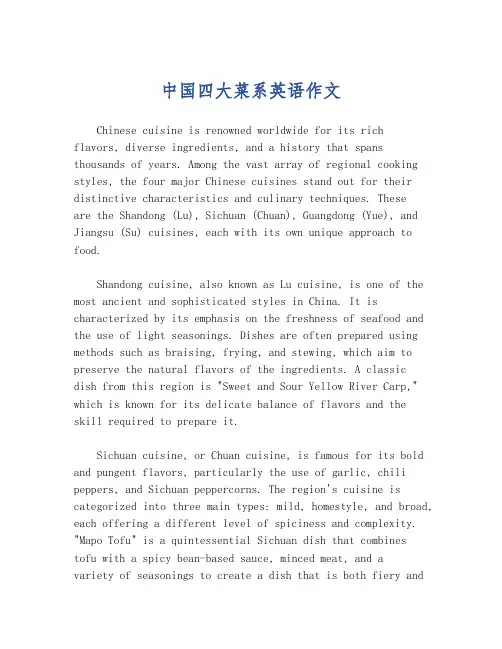
中国四大菜系英语作文Chinese cuisine is renowned worldwide for its rich flavors, diverse ingredients, and a history that spans thousands of years. Among the vast array of regional cooking styles, the four major Chinese cuisines stand out for their distinctive characteristics and culinary techniques. Theseare the Shandong (Lu), Sichuan (Chuan), Guangdong (Yue), and Jiangsu (Su) cuisines, each with its own unique approach to food.Shandong cuisine, also known as Lu cuisine, is one of the most ancient and sophisticated styles in China. It is characterized by its emphasis on the freshness of seafood and the use of light seasonings. Dishes are often prepared using methods such as braising, frying, and stewing, which aim to preserve the natural flavors of the ingredients. A classicdish from this region is "Sweet and Sour Yellow River Carp," which is known for its delicate balance of flavors and theskill required to prepare it.Sichuan cuisine, or Chuan cuisine, is famous for its bold and pungent flavors, particularly the use of garlic, chili peppers, and Sichuan peppercorns. The region's cuisine is categorized into three main types: mild, homestyle, and broad, each offering a different level of spiciness and complexity. "Mapo Tofu" is a quintessential Sichuan dish that combinestofu with a spicy bean-based sauce, minced meat, and avariety of seasonings to create a dish that is both fiery andsavory.Guangdong, or Yue, cuisine is celebrated for its light and refreshing flavors. It is the most international of the four major cuisines, with a strong emphasis on the quality of the ingredients and the presentation of the dishes. Yue cuisine is known for its variety of techniques, including steaming, roasting, and braising. "White Cut Chicken" is a popular dish that showcases the simplicity and elegance of Guangdong cooking, where the chicken is boiled to perfection and served with a dipping sauce.Jiangsu cuisine, or Su cuisine, is known for its delicate flavors and the meticulous preparation of its dishes. The region is famous for its freshwater fish and freshwater produce, which are often featured in its culinary creations. Su cuisine is divided into three smaller styles: Nanjing, Suzhou, and Yangzhou, each with its own set of culinary traditions. "Dongpo Pork" is a classic dish from this region, named after the famous poet Su Dongpo, and it is a testament to the slow-cooking techniques that are typical of Jiangsu cuisine.In conclusion, the four major Chinese cuisines each offer a unique gastronomic experience that reflects the diversity and depth of Chinese culinary culture. From the sea-breeze flavors of Shandong to the fiery kick of Sichuan, the refined elegance of Guangdong, and the subtle sophistication of Jiangsu, these cuisines are a testament to the rich tapestry of flavors that make up the culinary landscape of China.。